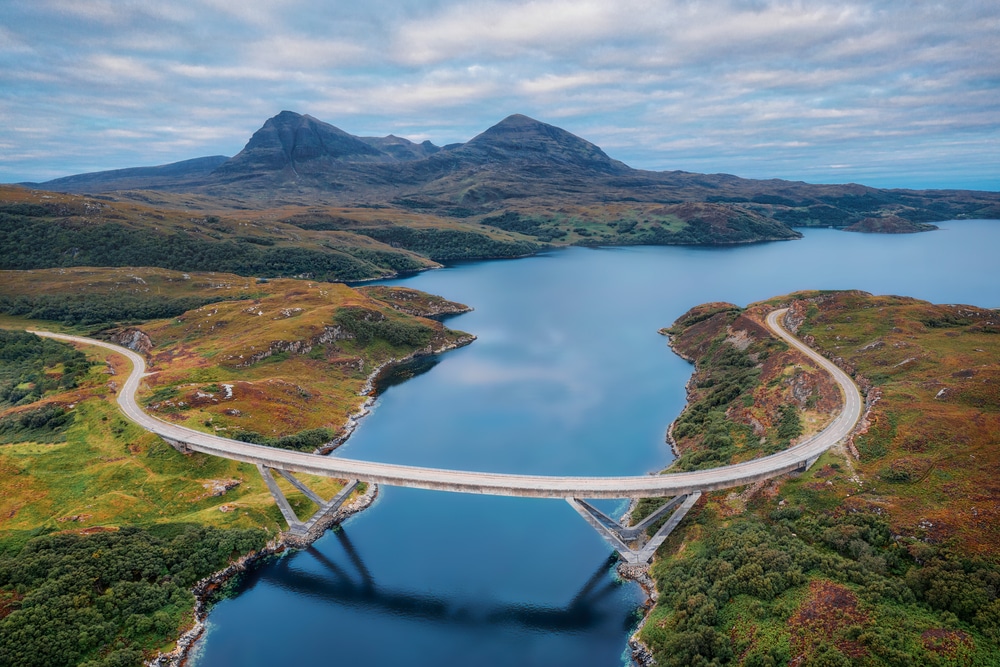
Scotland – one of the most charming yet rugged regions in the world, is one of the most breathtaking destinations to explore. The North Coast 500 is the most important route, as it offers more than 830 kilometres of fascinating nature and plenty of sights. A trip with a motorhome takes about a week (depending on the speed of the journey), but the landscape offers opportunities to linger. Discover impressive castles, lakes and the typical charm of a British country road.
Enchanting region – the special features of the North Coast 500
Dubbed the North Coast 500, the car route takes you through the most beautiful parts of Scotland. Designed as a round trip, you will discover sights, natural sections and of course coasts along the way. The Strip starts in Inverness, the capital of the region, where your trip will end. During the trip, you will drive along the east, west and north coasts until you finally make a detour inland and return to the starting point.
In terms of miles, the North Coast 500 is around 520 miles. This corresponds to a length of approx. 830 km in kilometres. If you were to drive directly from A to Z, you would need a maximum of 14 hours for the trip. However, since there is a lot to see and see on the way, most holidaymakers extend their trip to at least a week, preferably 14 days!
To avoid worrying about accommodation, you can rent a campervan in Scotland and have your home practically with you.
You’ve never heard of the North Coast 500, but only knew Route 66 before? That’s no wonder, as the increasingly popular route in Scotland was only launched in 2015. The aim was to promote tourism in Scotland and give visitors the opportunity to experience Scotland in all its beauty. In the meantime, the North Coast 500 has been nicknamed the “Route 66 of Scotland”.
Road trip with the motorhome? Why is it the best means of transport?
Theoretically, you can also travel Scotland and the North Coast 500 by car. However, most holidaymakers decide to travel by motorhome . There are a number of good reasons for this:
- Privacy and freedom: With your camper, you can travel independently of accommodation and sleep wherever you like. The route is predestined for multi-day trips and in the motorhome you have your privacy. You do not have to own your own camper, as there is the possibility of a rental car. Enjoy the benefits of a motorhome without spending high costs on the purchase.
- Discover beautiful places for longer: Have you discovered your personal highlight and would like to stay longer? With a camper, this is not a problem, because there are numerous pitches spread over the entire route.
- Family holiday with a lot in common: In the car, it quickly becomes uncomfortable when a larger group travels. In a motorhome, on the other hand, you enjoy togetherness, but still have the opportunity to retreat. If there are children with you, staying in a camper is much more pleasant than in a car.
- Cost savings through the motorhome: Although there are hotels and holiday apartments in many regions of Scotland, the costs are sometimes immense. With your camper, you always have your mobile home with you. Save money and spend the money on trips to Scotland’s most beautiful sights.
Plan your route – these highlights should be included

How you discover the North Coast 500 depends on your own wishes. Most tourists head east and then return via the western part. You can also do the route the other way around, as you like. The starting point is always the capital of the Highlands, which is an interesting sight in itself. Visit the Castle, plan a walk along the famous River Ness and stock up on supplies in the camper at the Victorian Market.
If you choose the classic route along the east coast, your first day trip could take you towards John O’Groats. It is the most northerly mainland village in Scotland and offers some great highlights. During the trip, it is worth making a stop on the Black Isle. There you can visit Chanonry Point and admire the hustle and bustle of the dolphins on the coast. They come all the way to the beach and are used to people watching them. Another highlight worth seeing is Dunrobin Castle, which belongs to the Earls of Sutherland. Here it is worth getting out and admiring and visiting the castle up close.
Finally, if your route continues westwards, you will encounter Dunnet Head. A small lighthouse awaits you here, washed by the wild Nordic tides. A piece of nature that you should capture with your camera. Queen Mum was also a regular guest here, because she knew how to protect the raw charm of Scotland. Just a few kilometres further on, you can visit the Castle of Mey, where the Queen stayed.
As a nature lover, it is worth walking along the coast and getting to know the secluded beaches. There is hardly any other region in Scotland where you can swim and enjoy far away from tourism. Finally, when you get to Durness, you should visit Smoo Cave, a sandstone cave that houses a waterfall.
If your route finally continues south, keep your eyes out of the window. Loch Maree offers unique panoramic views of Scottish nature and the mountains. You can make a stopover later in the village of Applecross, where you can feel a lot of Scottish culture. Many tourists stay here for a while before finally heading back towards Inverness on the route.
Other possible stops on the North Coast 500
Every traveler has his or her own individual preferences as to where the path should lead. Therefore, not all sights are visited equally. Are you a nature lover or would you like to learn more about Scottish culture? Here are some more popular stops you’ll encounter on the North Coast 500:
- Inverness Castle: You can visit this impressive castle at the beginning or end of your trip, as it is located at the start and end points.
- Black Isle: Although the peninsula is only touched briefly during the route, it is worth a stopover for some holidaymakers. You will have the opportunity to walk around it and get a glimpse of Scotland’s breadbasket along the way.
- Nigg’s oil rigs: On the way along the Cromarty Firth, you will have the opportunity to admire the anchored oil platforms. Some of them are under construction, others are currently undergoing repairs.
- The Gleonmorangie Distillery: For whiskey lovers, a stop is a must, because in Tain, a small village, lies this distillery with tradition!
- The burial mounds: If you’re feeling off the beaten track, head to Camster Cairns. These burial mounds are among the most impressive monuments of the time, opening up a piece of Scottish culture.
- The city of Ullapool: There is even more Scottish culture to enjoy in this small fishing town. Compared to all the other villages on the route, there is a lot of activity here and there is delicious food to enjoy.
Conclusion: The North Coast 500 – the perfect and individual trip
As you can see, the North Coast 500 is much more than just a track. You alone decide where to stop and which regions interest you. Whether alone on a self-discovery trip or together with your loved ones – the North Coast 500 shows you the most beautiful regions of Scotland and is a must for all road trip fans!

